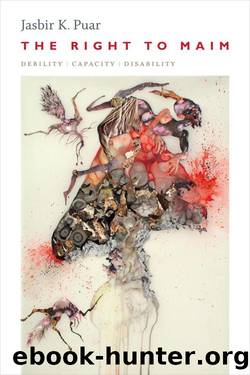The Right to Maim (ANIMA) by Jasbir K. Puar

Author:Jasbir K. Puar [Puar, Jasbir K.]
Language: eng
Format: epub
Publisher: Duke University Press
Published: 2017-10-11T06:00:00+00:00
THE BIOPOLITICS OF SETTLER COLONIALISM
These practices of bodily as well as infrastructural debilitation, loosely effaced in concerns about âdisproportionate force,â indicate the extension or perhaps the perversion of the âright to killâ claimed by states in warfare into what I am calling the âright to maim.â âThe right to maimâ supplements if not replaces âthe right to kill.â Maiming as intentional practice expands biopolitics beyond simply the question of âright of death and power over life.â Maiming becomes a primary vector through which biopolitical control is deployed in colonized space and hence not easily demarcated ânecroâ as it is mapped in Mbembeâs reworking of biopolitics. Mbembe discusses injury as a crucial element of enslavement: âThe slave is kept alive but in a state of injury ⦠slave life, in many ways, is a form of death-in-life.â57 Sticking with the binary of life and death with his formulation of âdeath-in-life,â he does not pursue injury and debilitation as altering living and dying as primary poles within which populations oscillate. The four quadrants remain; death is reiterated as the ultimate loss (of life). While other scholars of biopolitics have noted the centrality of disability to the deployment of biopolitical population management, these efforts generally remain wedded to the poles of living and dying within which life is toggled. That is to say, while the distinctions between living and dying are often recognized through the âcutsâ of race and the âfoldsâ of overlapping population construction and management, maiming, debilitation, and stunting are relatively undertheorized components of these cuts and folds; centering these processes may potentially alter presumed relations to living and dying altogether. Maiming is a practice that escapes definition within both legal and biopolitical or necropolitical frameworks because it does not proceed through making live, making die, letting live, or letting die. My reframing adds a critical axis to the four quadrants, insisting that debilitationâindeed, deliberate maimingâis not merely another version of slow death or of death-in-life or of a modulation on the spectrum of life to death. Rather, it is a status unto itself, a status that triangulates the hierarchies of living and dying that are standardly deployed in theorizations of biopolitics.
Alongside examining how and why Foucault elided a theory of colonial occupation in his formulation of biopolitics, we might also ask, what is biopolitics in the twenty-first century, especially as informed by the ongoing structure of settler colonialism? Recent interventions by Alexander Weheliye and Mel Chen raise critical issues about the formulation of race in the theorization of biopolitics.58 According to Weheliye, race only became important to Foucault when it entered the realms of European state management, not through the operations of colonialism. For this, Weheliye argues that the frame of biopolitics is foundationally flawed, for even as Foucault claims that the cut of race drives biopolitical distinctions, the severing of colonial occupation from a (belated) state racism relegates race to a derivative status. Weheliyeâs rather loose archival excavations of Foucaultâs work notwithstanding, what his and othersâ analyses lay bare
Download
This site does not store any files on its server. We only index and link to content provided by other sites. Please contact the content providers to delete copyright contents if any and email us, we'll remove relevant links or contents immediately.
Killers of the Flower Moon by David Grann(3761)
Machine Learning at Scale with H2O by Gregory Keys | David Whiting(3668)
Oathbringer (The Stormlight Archive, Book 3) by Brandon Sanderson(2666)
Will by Will Smith(2595)
Once Upon a Broken Heart by Stephanie Garber(2540)
Guns, Germs and Steel by Diamond Jared(2206)
Borders by unknow(2122)
It Starts With Us (It Ends with Us #2) by Colleen Hoover(2059)
The Room Where It Happened by John Bolton;(2038)
Friends, Lovers, and the Big Terrible Thing by Matthew Perry(2018)
The Color of Law by Richard Rothstein(1824)
HBR's 10 Must Reads 2022 by Harvard Business Review(1704)
The Strength In Our Scars by Bianca Sparacino(1702)
A Short History of War by Jeremy Black(1679)
Water Rights and the Environment in the United States by John Burch(1608)
Examples & Explanations: Administrative Law by William F. Funk & Richard H. Seamon(1557)
515945210 by Unknown(1525)
Pharmacy Practice and The Law by Richard Abood(1497)
That Every Man Be Armed by Stephen P. Halbrook(1482)
